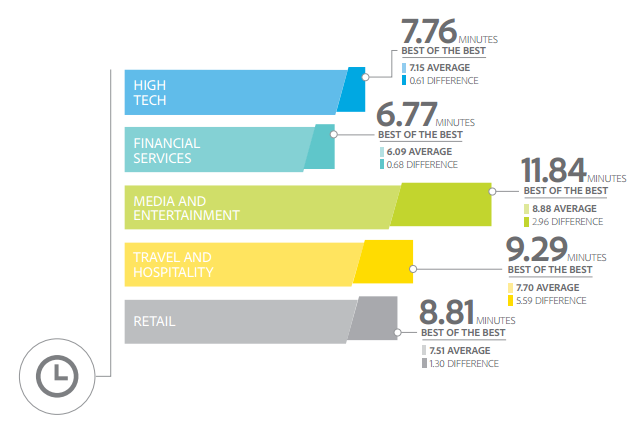Brafton reported back in January that 93 percent of marketers will allocate additional resources to building out their websites and blog content. While content creation for SEO has been a leading discussion in the marketing community, companies realize their sites must engage audiences, too. To improve website efficiency, companies need to understand the types of content that increase PageViews and reduce site bounce rates. It’s critical to understand how each metric plays into search visibility. A new study by Adobe examined how various U.S. industries compare in terms of site performance. The goal: To discover how various audiences interact with websites based on business sector.
The average site visit is 8.8 minutes, but entertainment sites with user-centric content keep people clicking longer.
Adobe noted that consumers spend more time on media and entertainment websites – an average of 12 minutes per visit. Of course, internet users often navigate to these web presences to relieve boredom and read about topics they’re passionate about. The more alarming insight gleaned from this report is the gap between entertainment sites and every other type of page. The average site performance clocks in at just 8.88 minutes per visit. Adobe suggests that entertainment sites feature a variety of custom content, from video to graphic to interaction media, which draws audiences in for longer periods of time. for pull quote: The average site visit is 8.8 minutes, but entertainment sites with user-centric content keep people clicking longer.
 Brands can learn a lot from Adobe’s study. While B2Bs and B2Cs cannot always transition their websites into entertainment hubs, they can produce a variety of branded content to reach consumers at various points of the sales cycle. When companies improve the stickiness of their websites, they benefit from more opportunities to increase website conversions. Increased dwell time always implies engagement. Still, longer visits won’t always correlate with higher conversions, but brands can use content analytics to compare time-on-site metrics against conversion metrics. The Adobe data shows that brands must spread their messages across the ‘net in various forms of media. Video marketing and infographic marketing can pique consumers’ interests in different ways than text-only campaigns.
Brands can learn a lot from Adobe’s study. While B2Bs and B2Cs cannot always transition their websites into entertainment hubs, they can produce a variety of branded content to reach consumers at various points of the sales cycle. When companies improve the stickiness of their websites, they benefit from more opportunities to increase website conversions. Increased dwell time always implies engagement. Still, longer visits won’t always correlate with higher conversions, but brands can use content analytics to compare time-on-site metrics against conversion metrics. The Adobe data shows that brands must spread their messages across the ‘net in various forms of media. Video marketing and infographic marketing can pique consumers’ interests in different ways than text-only campaigns.
When organizations create original media that explores their creative boundaries, they can tap into new markets that otherwise would have been overlooked. Brands that want to strengthen their websites this year should build out their blogs and news sections, but they also need to introduce new media types to develop a well-rounded presence.




